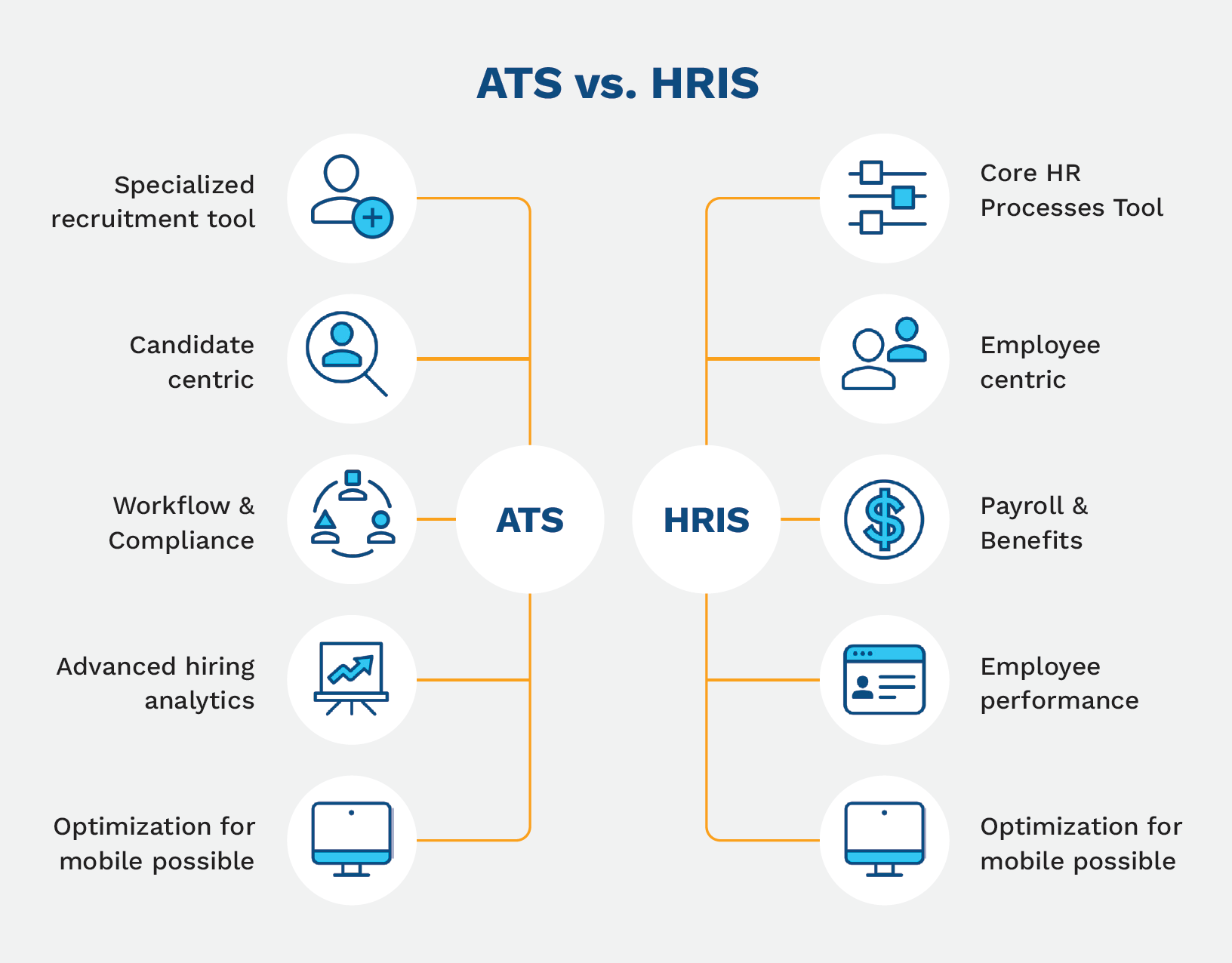In today’s competitive job market, it’s critical for growing businesses to have the best recruitment and retention tools for hiring and retaining talent.
While many Human Resource Information Systems (HRIS) have some recruiting functionality, they do not specialize in talent acquisition and often create more friction in the recruiting function.
Here are some of the critical differences between an ATS and HRIS:

An applicant tracking system (ATS) consists of the following:
- A specialized recruitment tool
- Is candidate centric
- Supports workflows and compliance
- Has advanced hiring analytics
- Offers optimization for mobile
A Human Resource Information System (HRIS) consists of the following:
- A core HR processes tool
- Is employee centric
- Supports payroll and benefits
- Focuses on employee retention and performance
- Offers optimization for mobile
Introducing a best of breed applicant tracking system (ATS) in the recruiting process helps companies attract and hire the best candidates by leveraging advanced functionality, including recruitment marketing, AI and automation, customizable workflows, and modern candidate communication tools.
Two Ways an ATS Enhances Your HRIS
Having a specialized ATS helps companies attract and hire the best candidates by leveraging advanced functionality, including recruitment marketing, AI and automation, customizable workflows, and modern candidate communication tools.
In the latest eBook, 5 Reasons an ATS Maximizes Your HRIS, you can learn five top reasons an ATS enhances your Human Resources Information System. Here we preview two of these areas:
#1: Streamline Recruiting Efficiency
- Improve recruiter and hiring manager efficiency: An ATS automates time-consuming manual tasks like resume screening, job posting, candidate communication, and interview scheduling. This frees up recruiters and hiring managers to focus on high-value activities like candidate engagement, interviewing, and decision-making.
- Decrease time-to-hire: An ATS streamlines the recruitment process, reducing the time it takes to identify, engage, and hire top talent. This, in turn, helps organizations optimize their workforce and achieve business goals faster.
- Align hiring goals to business outcomes: An ATS helps recruiters and hiring managers align their recruitment goals with business objectives. It provides insights into recruitment metrics, such as cost-per-hire, time-to-fill, and quality-of-hire, enabling organizations to make data-driven decisions that drive business outcomes.
- Focus on the recruiter experience: An ATS enhances the recruiter experience by providing a user-friendly interface, streamlined workflows, and automated communication tools. This, in turn, helps attract and retain top talent by creating a positive candidate experience.

#2: Strengthen Your Employer Brand
- Attract Top Talent Quicker: An ATS streamlines the recruiting process by automating job posting, resume screening, and candidate communication tasks. This means you can attract top talent quicker by reducing the time it takes to fill job openings and get them started in their role faster than your competition.
- More Easily Meet Hiring Goals: An ATS helps you stay on track with your hiring goals by providing real-time data on your recruiting pipeline. You can see where candidates are in the process, identify bottlenecks, and adjust as needed. This level of visibility and control ensures that you’re progressing toward your hiring goals and keeping pace with your business needs.
- Increase Applicant Conversion Rates: With an ATS, you can also communicate with candidates promptly and personally, building trust and rapport throughout the hiring process. You can customize your job postings and application forms to highlight your employer brand and communicate your value proposition to candidates.
- Decrease Time-to-Fill: An ATS can significantly decrease your time-to-fill by automating repetitive tasks, reducing manual errors, and improving collaboration among hiring teams. A faster hiring process enhances your reputation as an employer who values efficiency and respects candidates’ time.
- Enhance Talent Pool Quality: An ATS can enhance the quality of your talent pool by leveraging advanced sourcing and screening capabilities. With an ATS, you can also track candidate engagement and measure the effectiveness of your recruiting efforts, making data-driven decisions to improve your results.
See What an ATS and HRIS Can Do Together
Top businesses today recognize that talent acquisition is a specialized function that needs robust capabilities that focus on getting the right people into the company.
But remember, the best choice for growing companies should not focus on purchasing one or the other. Instead, it should focus on the benefits of recruitment technology working hand-in-hand with HR software.
Download our latest eBook 5 Reasons an ATS Maximizes Your HRIS to learn why these HR technologies can build a more comprehensive approach in your business to you attract, retain, and manage the best talent possible.




